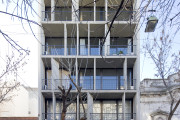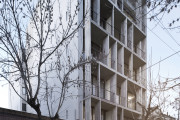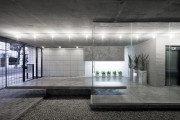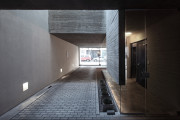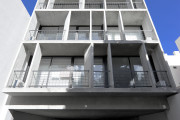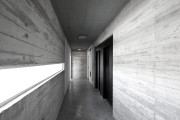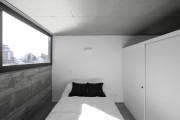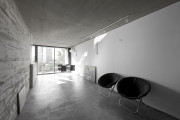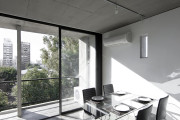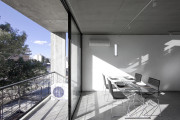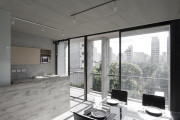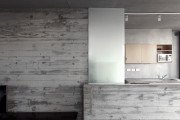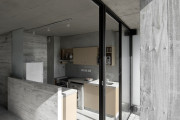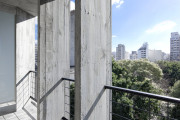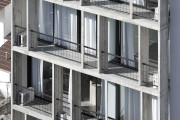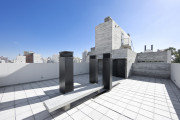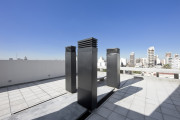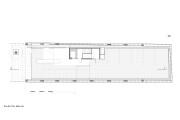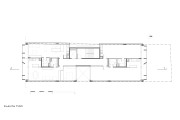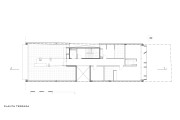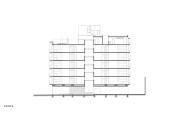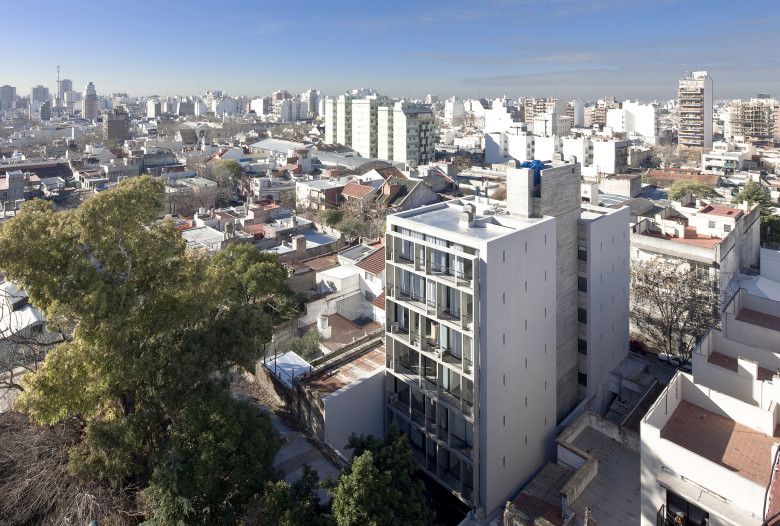EEUU Building
Location: Estados Unidos 4263, Autonomous City of Buenos Aires, Argentina Project Design: María Victoria Besonias – Luciano Kruk Collaborators: Arq. Leandro Pomies – Andrea Wohlgenannt Land Area: 277sqm Built Area: 1419sqm Construction year: 2009 Photos: Guilherme Morelli, Sergio Pirrone* Exhibited at the XIII Biennale of Architecture in Venice, August 2012
MEMORY
María Victoria Besonías
The place
We had to build an apartment building in a land of 8.66m width in Boedo, a zone of Buenos Aires that, without loosing the typical characteristics of neighborhood, has been changing its physiognomy because of the urban densification. The particularly of the land in where we have to intervene is that its back yard is adjacent with an urban square, with an important vegetation where is placed a football school and a small square. The views to this green lung match with the best orientation: the North.
The proposal
We think that, waiting for the changes that will happen in this sector in a short period of time, the building should be a piece lack of adjectives, neutral enough from its form as to live with what is present today and to accompany in the future, with a willingness concentrated on its constructive expression and its production process. For that reason it seems appropriate to propose a building whose facade does not show accents or joints and, if possible, is resolved with a single material. We also keep experimenting with the exposed concrete, as we have been doing in the summer houses in Mar Azul or permanent use houses in the province of Buenos Aires. We did this because we considered that this aesthetic constructive system, adapted as necessary, resolve the issue both of a key material easy to assimilate to different environments as the shortening of construction time, low future maintenance and budget within the standard. The major adaptation was leaving the exposed concrete walls only to resolve the facades, the vertical core and a number of internal partitions, which fulfill the dual function of being room dividers and sturdy structure. For the two party walls seemed logical to continue thinking about a traditional solution of concrete columns hidden in double masonry wall. We wanted also, as in the Concrete House, to resolve the facades like bellows between public and private sectors, with a series of vertical partitions that vary in position from floor to floor and allow solving the openings in each room with all the width and height available. The views to the interior of the units that face the street are protected by those elements and the views to the green space allow perceiving, as the user moves inside the apartment, ever-changing frames of that landscape. Another objective was that the ground floor should be free of functions in order to offer in the public space air, light and a view to the rear garden and, on the other hand, no housing units will affected by their contact with the public dimension. Finally we were concerned about each department, for it should have the greater flexibility of use as possible and we gave them a generous expansion, at the same time protected by the walls that organize the facades.
Functional organization
It is an open floor building with five typical floors of four units’ studio apartments each, and a sixth that develops a terrace and places of common use, plus a one bedroom housing unit.
By the pallier with city views and natural lighting you access, in the typical floor plan, to four mirrored units: two looking to the front, which are paired on the bathrooms and a kitchen, and two facing the back in the same situation. The exposed concrete walls that define those areas of service have, as stated above, a structural role and also delimit those “bellows” environments that provide more privacy to the main rooms of each housing unit. The creation of two small courtyards in the center of the plan follows the purpose of providing crossed ventilation to all units and additional lighting in the deepest area of the plan.
The constructive solution
The structural system, that solves the typical floor plan with supports in the center of it, required a transitional space to provide an open ground floor with supports only in the party walls. It was resolved by beams that receive burdens of the core partition system of the typical plan and transfer it to the party walls axes. The beam system is closed up and down with slabs, which also allow the diversion of the facilities’ upright to the edges without requiring a ceiling assembly to introduce another material.
The dividing walls were plastered and painted with white latex inside and a plastic plaster on the outside. The floors are concrete screed cloths divided by aluminum plates. The meeting between walls and the floor was resolved with a recessed aluminum profile as baseboard. The openings are of dark bronze anodized aluminum. The heating and cooling system was solved with individual split equipments.
From Mar Azul to Boedo
It was very interesting as a working experience for our studio to elaborate this adaptation of an aesthetic construction system originated in dialogue with an specific environment and program – summer houses in a maritime forest- to a subject and environment so different. We assumed the challenge that the language we’d developed in the houses could not withstand the passage of scale, the program changes and their location in the urban environment. The result confirms that a system of approach strategies for the projects and the aesthetic constructive solutions, posed a priori as body of ideas, does not limit the possibilities of resolution of the various problems that may arise, if the experimentation with each new assignment knows how to go through the sieve presented by the individual circumstances.
EEUU Building
Location: Estados Unidos 4263, Autonomous City of Buenos Aires, Argentina Project Design: María Victoria Besonias – Luciano Kruk Collaborators: Arq. Leandro Pomies – Andrea Wohlgenannt Land Area: 277sqm Built Area: 1419sqm Construction year: 2009 Photos: Guilherme Morelli, Sergio Pirrone* Exhibited at the XIII Biennale of Architecture in Venice, August 2012
MEMORY
María Victoria Besonías
The place
We had to build an apartment building in a land of 8.66m width in Boedo, a zone of Buenos Aires that, without loosing the typical characteristics of neighborhood, has been changing its physiognomy because of the urban densification. The particularly of the land in where we have to intervene is that its back yard is adjacent with an urban square, with an important vegetation where is placed a football school and a small square. The views to this green lung match with the best orientation: the North.
The proposal
We think that, waiting for the changes that will happen in this sector in a short period of time, the building should be a piece lack of adjectives, neutral enough from its form as to live with what is present today and to accompany in the future, with a willingness concentrated on its constructive expression and its production process. For that reason it seems appropriate to propose a building whose facade does not show accents or joints and, if possible, is resolved with a single material. We also keep experimenting with the exposed concrete, as we have been doing in the summer houses in Mar Azul or permanent use houses in the province of Buenos Aires. We did this because we considered that this aesthetic constructive system, adapted as necessary, resolve the issue both of a key material easy to assimilate to different environments as the shortening of construction time, low future maintenance and budget within the standard. The major adaptation was leaving the exposed concrete walls only to resolve the facades, the vertical core and a number of internal partitions, which fulfill the dual function of being room dividers and sturdy structure. For the two party walls seemed logical to continue thinking about a traditional solution of concrete columns hidden in double masonry wall. We wanted also, as in the Concrete House, to resolve the facades like bellows between public and private sectors, with a series of vertical partitions that vary in position from floor to floor and allow solving the openings in each room with all the width and height available. The views to the interior of the units that face the street are protected by those elements and the views to the green space allow perceiving, as the user moves inside the apartment, ever-changing frames of that landscape. Another objective was that the ground floor should be free of functions in order to offer in the public space air, light and a view to the rear garden and, on the other hand, no housing units will affected by their contact with the public dimension. Finally we were concerned about each department, for it should have the greater flexibility of use as possible and we gave them a generous expansion, at the same time protected by the walls that organize the facades.
Functional organization
It is an open floor building with five typical floors of four units’ studio apartments each, and a sixth that develops a terrace and places of common use, plus a one bedroom housing unit.
By the pallier with city views and natural lighting you access, in the typical floor plan, to four mirrored units: two looking to the front, which are paired on the bathrooms and a kitchen, and two facing the back in the same situation. The exposed concrete walls that define those areas of service have, as stated above, a structural role and also delimit those “bellows” environments that provide more privacy to the main rooms of each housing unit. The creation of two small courtyards in the center of the plan follows the purpose of providing crossed ventilation to all units and additional lighting in the deepest area of the plan.
The constructive solution
The structural system, that solves the typical floor plan with supports in the center of it, required a transitional space to provide an open ground floor with supports only in the party walls. It was resolved by beams that receive burdens of the core partition system of the typical plan and transfer it to the party walls axes. The beam system is closed up and down with slabs, which also allow the diversion of the facilities’ upright to the edges without requiring a ceiling assembly to introduce another material.
The dividing walls were plastered and painted with white latex inside and a plastic plaster on the outside. The floors are concrete screed cloths divided by aluminum plates. The meeting between walls and the floor was resolved with a recessed aluminum profile as baseboard. The openings are of dark bronze anodized aluminum. The heating and cooling system was solved with individual split equipments.
From Mar Azul to Boedo
It was very interesting as a working experience for our studio to elaborate this adaptation of an aesthetic construction system originated in dialogue with an specific environment and program – summer houses in a maritime forest- to a subject and environment so different. We assumed the challenge that the language we’d developed in the houses could not withstand the passage of scale, the program changes and their location in the urban environment. The result confirms that a system of approach strategies for the projects and the aesthetic constructive solutions, posed a priori as body of ideas, does not limit the possibilities of resolution of the various problems that may arise, if the experimentation with each new assignment knows how to go through the sieve presented by the individual circumstances.

